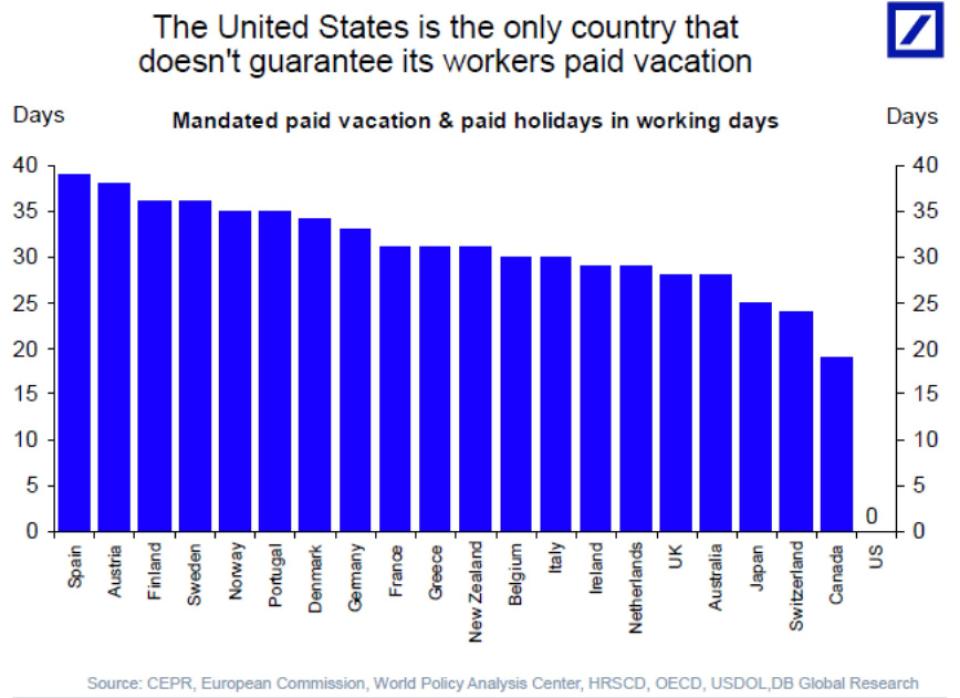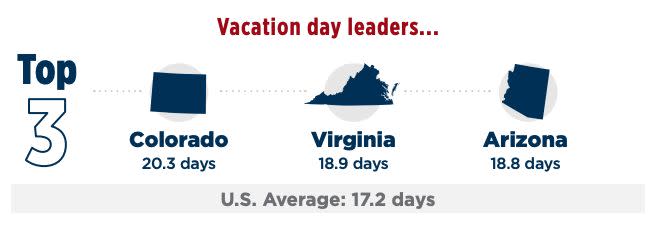U.S. paid vacation policy is embarrassing: Chart
America: the land of the free, and the vacation deprived.
A recent study by D.C.-based think-tank Center for Economic and Policy Research found that out of the 21 richest countries in the world, the U.S. “continues to be the only advanced economy that does not guarantee its workers paid vacation.” The report added that “without a federal paid vacation policy, close to one in four Americans have no paid vacation… [and] no paid holidays.”
It also revealed a massive gap between full-time and part-time workers, that while 90% of full-timers got paid vacation and paid holidays, less than half of part-timers received the same benefits.
This chart from Deutsche Bank illustrates the point:

‘Significant disparity between the United States and the rest of the world’s rich countries’
The key reason why the U.S. lags so far behind is because it is the “only advanced economy that does not mandate any paid vacation time for workers,” the study explained.
The U.S. is also one of the only countries that did not require employers to offer paid annual leave. So while “most developed countries offer at least six paid holidays a year… the United States provides none,” the report stated.
And even if employees are getting paid days off, the average private sector worker is only likely to see about 10 paid vacation days and 6 paid holidays — which is “far less than in almost every advanced economy except Japan.”
In contrast, thanks to the European Union’s rules, European countries had at least four weeks — or 20 working days — of paid vacation for all workers who are employed in EU member countries.
Spain ranked as the most generous, offering workers 14 paid holidays, followed by Austria, Germany, and Portugal.

‘Distribution of those benefits is extremely unequal’ between full-time and part-time workers
The study also found a big gap between full-time and part-time employees and how they were granted time off.
In the U.S., while 90% of full-time private sector workers received paid vacation and holiday time, only 40% of part-timers received paid vacation, and 44% got paid holidays.
There was an income gap as well: The top 25% of income earners received paid annual vacation and paid holidays at 91% and 93% respectively, while the bottom 25% received 52% and 54% respectively.
“For U.S. employees who do receive paid vacation and holidays, the distribution of those benefits is extremely unequal,” the report found.

Colorado, Virginia and Arizona offer longest
Even within the U.S., there are several states that are far more generous than others.
In a separate study by U.S. Travel in 2018, Colorado offered the most amount of vacation days to employees within the state, at 20.3.
Virginia was close behind with 18.9 days, followed by Arizona at 18.8 days.
At the far end of the rankings, Montana offered the lowest number of vacation days at 16.3, followed by Delaware and Rhode Island, both at 16.5.
The national average was 17.2 days.
Aarthi is a writer for Yahoo Finance. Follow her on Twitter @aarthiswami.
Read more:
Household debt hits $13.6 trillion as student loan and credit card delinquencies rise
Elizabeth Warren unveils 'broad cancellation plan' for student debt
'The clock is ticking' on U.S. consumer loans — and that could mean a slowdown, Deutsche Bank warns
Read the latest financial and business news from Yahoo Finance
Follow Yahoo Finance on Twitter, Facebook, Instagram, Flipboard, SmartNews, LinkedIn, YouTube, and reddit.

 money
money 
